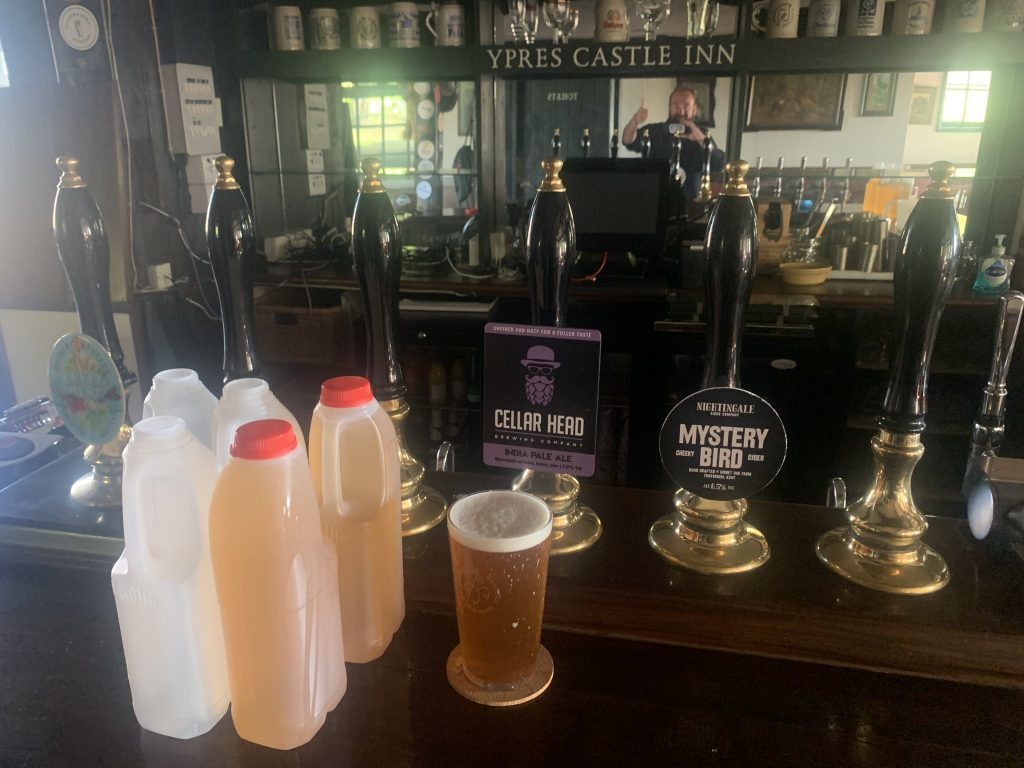 Another week in lock down. What is there to say? Things are moving along a bit of a path, maybe showing a bit of the light at the end of the tunnel. Maybe. I hope the world hasn’t turned too upside down where you are. Things are looking a bit better in Rye, England where as we see above James Jeffrey has created the “Beer Delivery by Stonch!“* service. I’m not sure of the legalities of it all but how lovely to get a couple of pints of fresh drawn ale delivered from the pub. We’ve had new laxer laws pub in place here so no doubt there are more novel opportunities out there to be discussed.
Another week in lock down. What is there to say? Things are moving along a bit of a path, maybe showing a bit of the light at the end of the tunnel. Maybe. I hope the world hasn’t turned too upside down where you are. Things are looking a bit better in Rye, England where as we see above James Jeffrey has created the “Beer Delivery by Stonch!“* service. I’m not sure of the legalities of it all but how lovely to get a couple of pints of fresh drawn ale delivered from the pub. We’ve had new laxer laws pub in place here so no doubt there are more novel opportunities out there to be discussed.
The new home delivery here in Ontario has been so successful that some breweries are now being drained:
Thirsty Ottawans in lockdown are drinking beer faster than local breweries can produce it, causing some to run dry of their most popular varieties. The demand for canned beer is keeping some breweries afloat during the economic slowdown caused by the COVID-19 pandemic. “We’re definitely moving beer faster now,” said Laura Behzadi, co-founder of Bicycle Craft Brewery. “Our beers will sell out in a day or two, sometimes three.” Like many craft beer breweries and brew pubs across the province, Bicycle has shifted solely to taking orders online since public health officials in Ontario commanded restaurants to close in mid-March.
Not every brewery has been able to adapt as Britain’s Left Handed Giant shared in detail:
Aim no 1 has been to try to find new revenue streams after the loss of both our bars, and around 85% of trade custom. All bars are shut and as such all trade we used to sell to wholesalers and bars direct has dried up. Worryingly very little of the beer we sold on credit through the early part of the year has now been paid for. Most bars and shops that have been shut have closed their books and are unable to pay. So not only have we lost current trade, we are staring at the possibility of losing the revenue generated from sales before the crisis even began. We are still paying our bills so we have hugely negative cash flow. All the money we owed going out, but very little of what’s owed coming in.
I do find the folk writing about today’s new situation the most interesting. By the way, here is great writing advice from Al Purdy, who wrote this. And this was my favorite tweet this week about the change:
Living next to a pub, I’m used to late-night revellers shouting but what really annoyed me was the chap who would imitate an owl hoot around 2.30am every night. Now pubs are shut I realise the hooting still goes on and it’s not a drunk. It is actually an owl.
Looking for something to do? Now you can volunteer to transcribe records on line with the Archives of the Province of Nova Scotia! Might be something about beer in them there archives. I wrote a paper in law school in that there building on the Court of Vice-Admiralty cases 1750 to 1760 on liquor violations. See, the local pre-Cajun Acadians liked their brandy but the conquering British wanted them to buy rum. It all ended up badly.
And while I want to hear about today, the odd post about what is missed is good, this one about a beer garden once visited in Germany:
I find myself thinking back to Bamberg. It was the height of summer and the middle of a Europe-wide heat wave with the sorts of temperatures that I, as a woman from the North of England, rarely come across; high 30s, each step an effort and bringing with it waves of exhaustion. We climb up a hill on the outskirts of town. It feels steeper than it is, the progress takes longer than it should and I grumble that it better be worth it.
Did I mention I wrote an actual post last weekend about actual brewing history? Dorchester Ale!!! Or beer… Dorchester Ale and Beer!!!!
Matthew L has continued his revivalist blogging (when he is not working to stock grocery shelves) with his admission that, along with Paisley patterned shirts, he has a thing for that thing Buckfast:
For me, the past two weeks have been like this – get up, go to work, stay there till Midnight (for maximum social distancing), go home, eat, have a few beers and go back to bed. The thing about this routine, is you have very little to look forward too at the end of the week. Basically, it’s the same as a work day, only without the work. And as such, you try to find the smallest thing about your old life to hang onto. With me, it will be Buckfast Sunday. Let me explain – every Sunday at 3pm, myself and few other regulars at a local micropub have a glass of the infamous Buckfast Tonic wine. Like all the best traditions, nobody really knows how it started (or even how a craft beer focused bar ended up stocking notorious Ned juice).
ATJ created a very interesting participatory project when he tweeted this and received many answers to his hypothesis:
Doing some research on regional beer styles, it’s my belief that the idea of regional differences in beer preferences has all but died out in the UK but am willing to be proved wrong if anyone has any examples. Be good to read all views based on personal experiences.
Robsterowski’s reply was practically haiku… or maybe half a sonnet: “Golden, flinty bitter in West Yorkshire. Sweet yet hoppy golden bitter in the West Midlands. Heavy in Scotland. Lightly flavoured quaffing bitter in Cumbria.” There are more than fifty other responses. Worth the read.
Finally, as if things could not be worse, they did. As I mentioned last weekend on the bits of social media I use, I have been particularly struck by the horrible news from Nova Scotia because the crimes occurred where I used to live. The roads around Portapique were where I worked in high school and undergrad summer jobs, doing maintenance jobs in senior citizen housing or working up dirt roads piling pulp wood. Where we had summer beach parties, one of which included a pal’s car floating in the sea after being caught parked too near the world’s highest tides. School friends lived there along the northern shore of the Minas Basin. Some now back retired forty years later. Terrible. I mark this here to remember how it happened in a week like any other week, when we were already dealing with rotten news.
Having said that, we do know that things will be better and another day and week is coming. Keep writing and keep reading. Check in with Boak and Bailey most Saturdays, plus more at the OCBG Podcast on Tuesdays and sometimes on a Friday posts at The Fizz as well. And sign up for Katie’s weekly newsletter, too. Plus the venerable Full Pint podcast. And Fermentation Radio with Emma Inch. There’s the AfroBeerChick podcast as well! And have a look at Brewsround‘s take on the beer writing of the week. Thanks for stopping by.

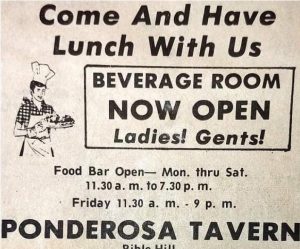
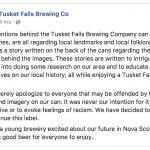

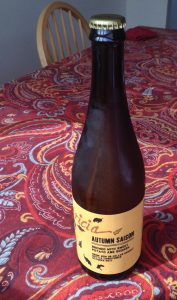


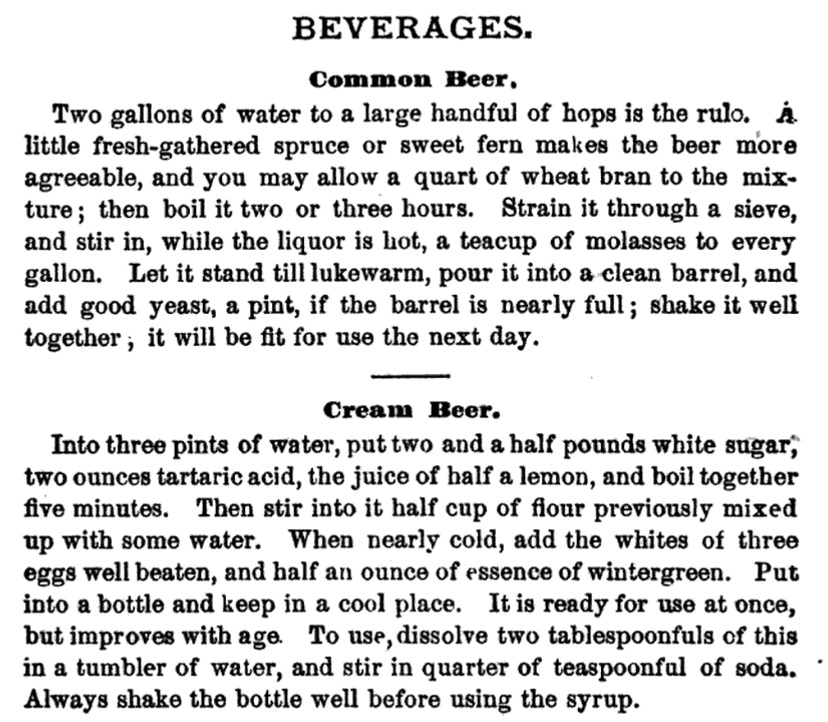 The book De Witt’s Connecticut Cook Book, and Housekeeper’s Assistant from
The book De Witt’s Connecticut Cook Book, and Housekeeper’s Assistant from  The Hall study has a number of other tidbits of information that frame the downtown scene, starting with this map. I kid myself that I could sketch this blind folded in a isolation tank but most of the locations pop back to mind immediately. The map also illustrates the general university student flow from southwest to north east, the march many evenings being from Your Father’s Mustache to the Lower Deck. And there is a concise description of what “draft” was:
The Hall study has a number of other tidbits of information that frame the downtown scene, starting with this map. I kid myself that I could sketch this blind folded in a isolation tank but most of the locations pop back to mind immediately. The map also illustrates the general university student flow from southwest to north east, the march many evenings being from Your Father’s Mustache to the Lower Deck. And there is a concise description of what “draft” was: